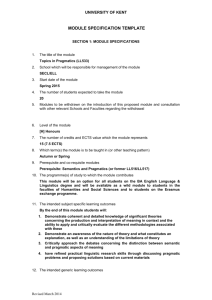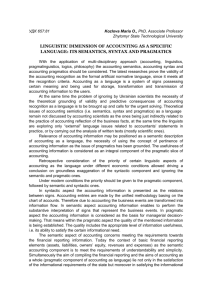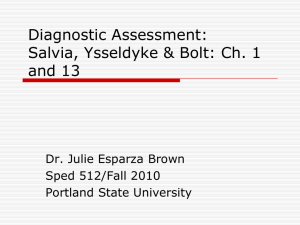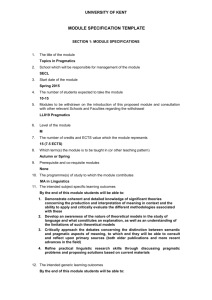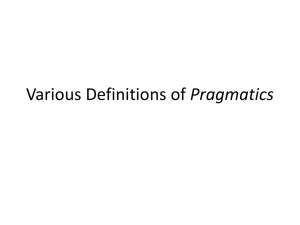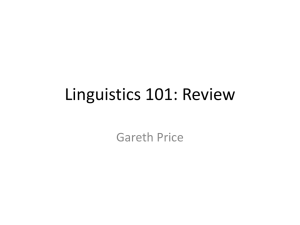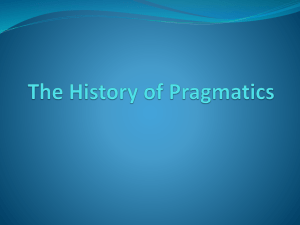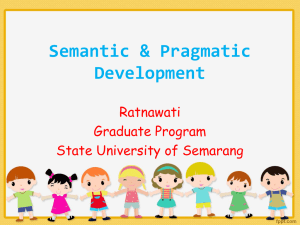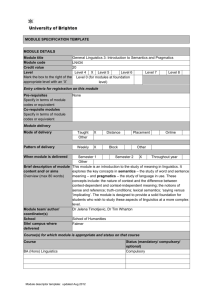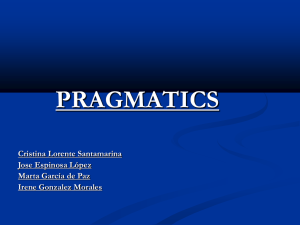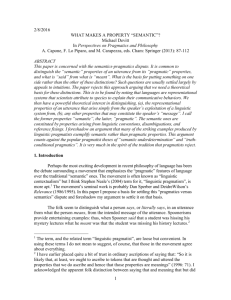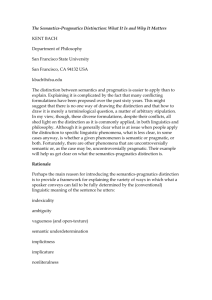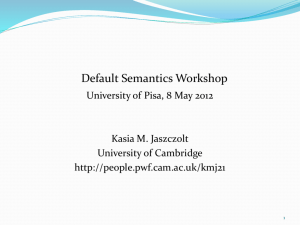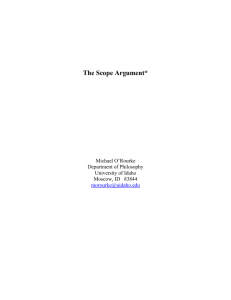here
advertisement
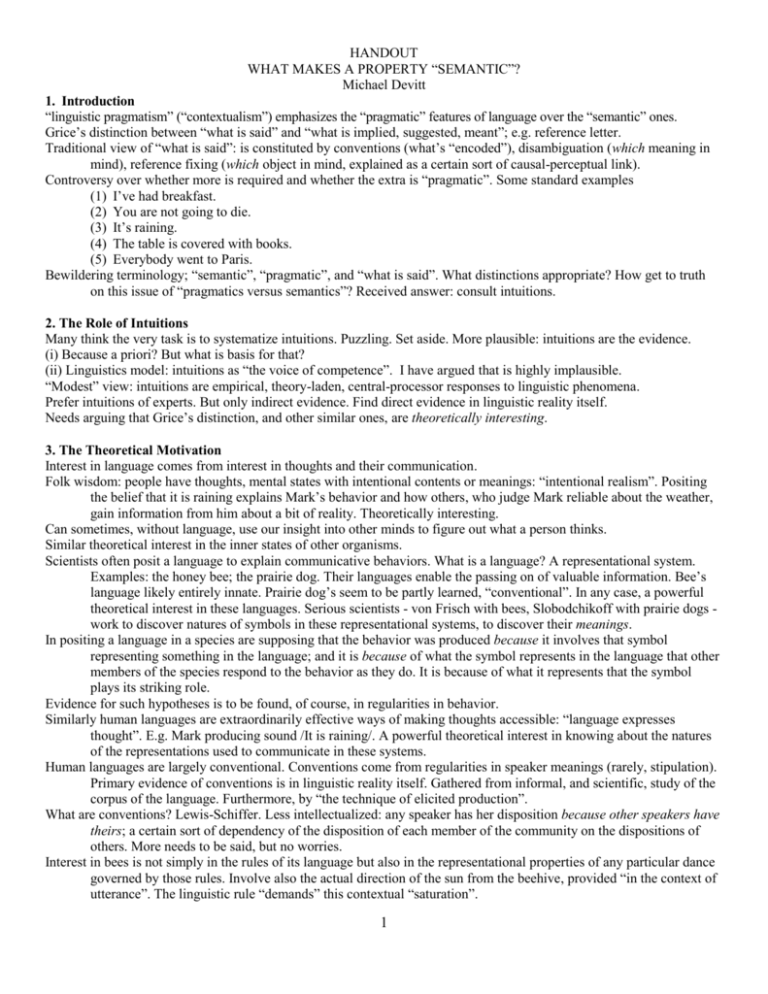
HANDOUT WHAT MAKES A PROPERTY “SEMANTIC”? Michael Devitt 1. Introduction “linguistic pragmatism” (“contextualism”) emphasizes the “pragmatic” features of language over the “semantic” ones. Grice’s distinction between “what is said” and “what is implied, suggested, meant”; e.g. reference letter. Traditional view of “what is said”: is constituted by conventions (what’s “encoded”), disambiguation (which meaning in mind), reference fixing (which object in mind, explained as a certain sort of causal-perceptual link). Controversy over whether more is required and whether the extra is “pragmatic”. Some standard examples (1) I’ve had breakfast. (2) You are not going to die. (3) It’s raining. (4) The table is covered with books. (5) Everybody went to Paris. Bewildering terminology; “semantic”, “pragmatic”, and “what is said”. What distinctions appropriate? How get to truth on this issue of “pragmatics versus semantics”? Received answer: consult intuitions. 2. The Role of Intuitions Many think the very task is to systematize intuitions. Puzzling. Set aside. More plausible: intuitions are the evidence. (i) Because a priori? But what is basis for that? (ii) Linguistics model: intuitions as “the voice of competence”. I have argued that is highly implausible. “Modest” view: intuitions are empirical, theory-laden, central-processor responses to linguistic phenomena. Prefer intuitions of experts. But only indirect evidence. Find direct evidence in linguistic reality itself. Needs arguing that Grice’s distinction, and other similar ones, are theoretically interesting. 3. The Theoretical Motivation Interest in language comes from interest in thoughts and their communication. Folk wisdom: people have thoughts, mental states with intentional contents or meanings: “intentional realism”. Positing the belief that it is raining explains Mark’s behavior and how others, who judge Mark reliable about the weather, gain information from him about a bit of reality. Theoretically interesting. Can sometimes, without language, use our insight into other minds to figure out what a person thinks. Similar theoretical interest in the inner states of other organisms. Scientists often posit a language to explain communicative behaviors. What is a language? A representational system. Examples: the honey bee; the prairie dog. Their languages enable the passing on of valuable information. Bee’s language likely entirely innate. Prairie dog’s seem to be partly learned, “conventional”. In any case, a powerful theoretical interest in these languages. Serious scientists - von Frisch with bees, Slobodchikoff with prairie dogs work to discover natures of symbols in these representational systems, to discover their meanings. In positing a language in a species are supposing that the behavior was produced because it involves that symbol representing something in the language; and it is because of what the symbol represents in the language that other members of the species respond to the behavior as they do. It is because of what it represents that the symbol plays its striking role. Evidence for such hypotheses is to be found, of course, in regularities in behavior. Similarly human languages are extraordinarily effective ways of making thoughts accessible: “language expresses thought”. E.g. Mark producing sound /It is raining/. A powerful theoretical interest in knowing about the natures of the representations used to communicate in these systems. Human languages are largely conventional. Conventions come from regularities in speaker meanings (rarely, stipulation). Primary evidence of conventions is in linguistic reality itself. Gathered from informal, and scientific, study of the corpus of the language. Furthermore, by “the technique of elicited production”. What are conventions? Lewis-Schiffer. Less intellectualized: any speaker has her disposition because other speakers have theirs; a certain sort of dependency of the disposition of each member of the community on the dispositions of others. More needs to be said, but no worries. Interest in bees is not simply in the rules of its language but also in the representational properties of any particular dance governed by those rules. Involve also the actual direction of the sun from the beehive, provided “in the context of utterance”. The linguistic rule “demands” this contextual “saturation”. 1 Similarly with human languages and indexicals: a linguistic rule “demands” a certain contextual “saturation” in constituting the property of theoretical interest. Also a demand for disambiguation: multiplicity of conventions demands disambiguation to arrive at the representational properties that interest. So, our interest in the representational properties that an utterance has simply in virtue of the speaker’s exploitation of a language motivates an interest in properties arising from: (i) convention, (ii) disambiguation, (iii) saturation. Properties thus motivated are part of “what is said”. Also may call what is said, “the proposition said”. Assume nothing more to what is said than (i) to (iii). Argue in Overlooking Conventions that much of the pragmatist phenomena fall under this notion of what is said; see sec. 7. A “message” is a thought a speaker intends to convey: “the proposition meant”; may differ from what is said. So, saying that p does not entail meaning that p. Differences may come from implicatures, pragmatic enrichments or impoverishments. 4. Terminology “Narrow semantics”: the study of only (i), the (largely) conventional properties rules of a language. (Wide) “semantics”: the study of what is said: (i), (ii), and (iii). Relatedly, “semantic property” and “semantic processes”. Upsetting to Bach and Salmon. But just a verbal issue. Really vexed issue of “pragmatics”: (1) the study of communication, “interpretation”: “pragmatic” processes by which hearer comes to understand the message conveyed. This pragmatics obviously very different from semantics, the study of certain properties of an utterance; no way in which semantics and pragmatics are rivals. What then are we to make of the dispute over pragmatics versus semantics? “Pragmatics” (2): the study of “pragmatic” properties of an utterance, ones that are not semantic, in some preferred sense, and yet contribute to a message conveyed; e.g implicatures, expansions, contractions. Pragmatics versus semantics dispute is intelligible only if “pragmatics” is (2). So ‘pragmatics’, as commonly used (and as used by me) is ambiguous. Not given enough attention Many use ‘pragmatic’ to cover more properties of an utterance than the ones that are nonsemantic in my sense: might call these “wide-pragmatic” properties. Unfortunate concealing of an important distinction. 5. Communication Pragmatics (1) must start with semantics, the assigning of “semantic values” to expressions. But it must go much further: How are these semantic properties used in communication? 6. The Semantics-Pragmatics Dispute Key semantic issue comes down to: What are the conventions that constitute the system? Answer by seeing if a convention is the best explanation of a regularity in behavior. Traditional view, implicitly: what is said, made up of (i) to (iii), is standardly the message conveyed. The pragmatists use examples like (1) to (5) to mount a formidable challenge; truth conditions are “semantically underdetermined”; a new theoretical framework is called for. Overlooking Conventions argues that many of the pragmatists’ examples exemplify properties of sorts (i) to (iii). A view that is very much in the spirit of the tradition. No new framework is called for. E.g. definite descriptions; see (4) above. “The Argument from Convention”: we regularly use descriptions referentially. The best explanation is a semantic one: there is a convention of using descriptions referentially. View goes against pragmatist thesis of “semantic underdetermination”. Also against “truth-conditional pragmatics”: the meaning of the sentence (+disambiguation+reference fixing) does not alone yield a truth-conditional content: needs to be pragmatically supplemented and can be so in indefinitely many ways yielding indefinitely many truth conditions. 2
